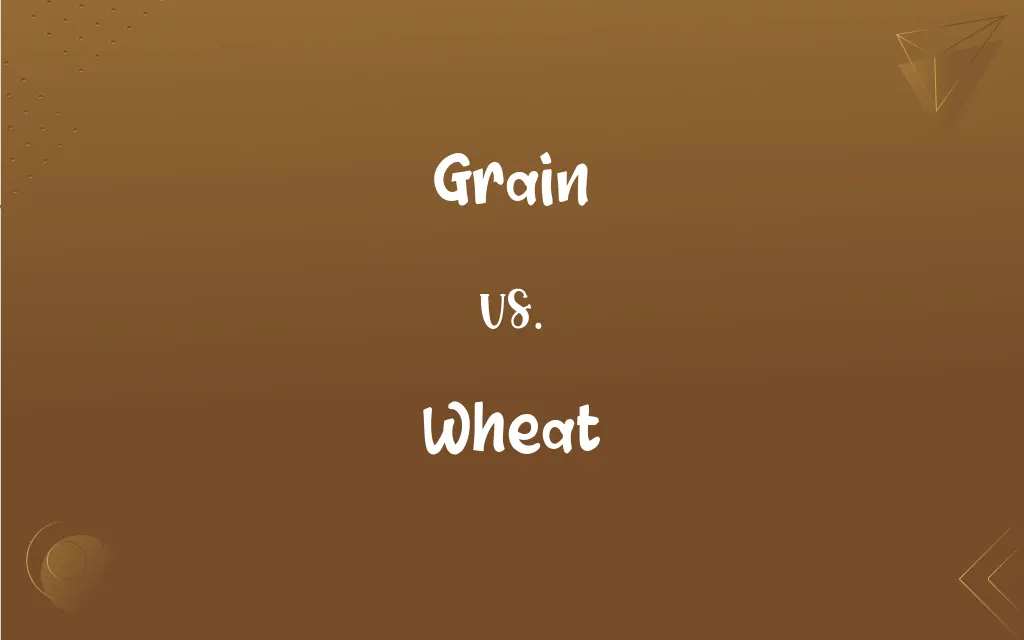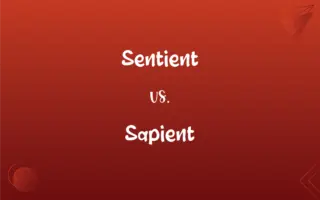Grain vs. Wheat: What's the Difference?
Edited by Aimie Carlson || By Harlon Moss || Published on January 11, 2024
Grain is a small, hard, dry seed used for food; includes wheat, rice, corn, etc. Wheat is a type of grain known for its golden ears; primarily used in bread, pasta, and cereals.

Key Differences
Grain refers to the seeds of various grass-like plants used for food, such as wheat, rice, and barley. Wheat, specifically, is a type of grain distinguished by its unique characteristics and uses, like bread-making.
Grain encompasses a wide variety of seeds, while wheat is known for its specific use in products like flour and bread. Wheat grains are processed differently than other grains, focusing on their gluten content.
All wheat is grain, but not all grain is wheat; wheat is merely one type within the larger category of grains. Different grains, including wheat, have varied nutritional profiles and culinary uses.
Grains serve as a fundamental food source globally, with wheat being particularly dominant in Western diets. Wheat’s versatility in cooking is distinct from other grains, which might be better suited for different dishes.
The cultivation of grain is diverse, covering various species including wheat. Wheat farming, however, has specific climate and soil requirements, distinguishing it from other grain crops.
ADVERTISEMENT
Comparison Chart
Definition
The seeds of various cereals and grasses
A specific type of grain used for flour and bread
Variety
Includes wheat, rice, corn, barley, etc.
A single variety within the grain category
Usage
Used in a wide range of foods and purposes
Primarily used in bread, pasta, and cereal
Cultivation
Grown in diverse climates and conditions
Requires specific conditions for optimal growth
Nutritional Profile
Varies widely depending on the type
High in carbohydrates, fiber, and gluten
ADVERTISEMENT
Grain and Wheat Definitions
Grain
Food Source.
Grain is a staple in many diets around the world.
Wheat
Cereal Plant.
Wheat fields stretched across the countryside.
Grain
Raw Material.
The mill grinds grain into flour.
Wheat
Flour Source.
Wheat is ground to make flour for baking.
Grain
Seed.
Farmers harvested the grain from their vast fields.
Wheat
Cultivated Crop.
Farmers cultivated wheat on their land.
Grain
Agricultural Product.
The country's economy relies heavily on grain exports.
Wheat
Gluten Content.
Wheat is known for its high gluten content.
Grain
Variety.
Her diet included a wide range of grain.
Wheat
Staple Food.
Wheat is a staple in Western diets.
Grain
A small, dry, one-seeded fruit of a cereal grass, having the fruit and the seed walls united
A single grain of wheat.
Gleaned the grains from the ground one at a time. Also called caryopsis.
Wheat
Any of various annual cereal grasses of the genus Triticum of the Mediterranean region and southwest Asia, especially T. aestivum, widely cultivated in temperate regions in many varieties for its commercially important edible grain.
Grain
The fruits of cereal grasses especially after having been harvested, considered as a group
The grain was stored in a silo.
Wheat
The grain of any of these grasses, ground to produce flour used in breads, pasta, and other foods.
Wheat
(countable) Any of several cereal grains, of the genus Triticum, that yields flour as used in bakery.
Wheat
(uncountable) A light brown colour, like that of wheat.
Wheat
Wheaten, of a light brown colour, like that of wheat.
Wheat
A cereal grass (Triticum vulgare) and its grain, which furnishes a white flour for bread, and, next to rice, is the grain most largely used by the human race.
Wheat
Annual or biennial grass having erect flower spikes and light brown grains
Wheat
Grains of common wheat; sometimes cooked whole or cracked as cereal; usually ground into flour
FAQs
What is wheat?
Wheat is a type of grain, specifically used for making flour and bread.
What makes wheat unique among grains?
Wheat is unique due to its high gluten content and its primary use in bread and pasta.
What is grain?
Grain refers to the seeds of cereals and grasses used for food.
How is grain harvested?
Grain, including wheat, is harvested from the fields using various agricultural techniques.
Are there different types of wheat?
Yes, there are several types of wheat, each suited for different culinary uses.
Are all grains similar to wheat?
No, different grains have varied characteristics and uses, though wheat is a common type.
Can wheat be used interchangeably with other grains?
Not always, as wheat has specific properties that differ from other grains.
What are the main uses of grain?
Grain is used for food, animal feed, and sometimes in industrial products.
What’s the difference in taste between wheat and other grains?
Wheat has a distinctive taste, often described as nutty, which differs from other grains.
Is wheat healthier than other grains?
Healthiness varies; wheat is nutritious but other grains also offer different health benefits.
Can people with gluten intolerance eat wheat?
No, people with gluten intolerance usually need to avoid wheat.
Are there any non-food uses of grain?
Yes, some grains are used in biofuels, industrial products, and animal feed.
How is wheat processed?
Wheat is processed by milling it into flour, which is then used for various food products.
What dishes commonly use wheat?
Wheat is commonly used in bread, pasta, pastries, and cereals.
Is wheat easy to grow?
Wheat requires specific conditions but is widely cultivated due to its adaptability.
Can grain be stored for long periods?
Yes, most grains, including wheat, can be stored for long periods if kept dry.
Is wheat used in all cultures’ cuisines?
Wheat is prominent in many, but not all, cultures, with some relying more on other grains.
What's the environmental impact of growing grain?
The impact varies, but large-scale grain farming, including wheat, can affect biodiversity and soil health.
How does climate affect wheat cultivation?
Wheat grows best in temperate climates and requires specific soil and weather conditions.
What’s the nutritional value of wheat?
Wheat is high in carbohydrates, fiber, and contains gluten.
About Author
Written by
Harlon MossHarlon is a seasoned quality moderator and accomplished content writer for Difference Wiki. An alumnus of the prestigious University of California, he earned his degree in Computer Science. Leveraging his academic background, Harlon brings a meticulous and informed perspective to his work, ensuring content accuracy and excellence.
Edited by
Aimie CarlsonAimie Carlson, holding a master's degree in English literature, is a fervent English language enthusiast. She lends her writing talents to Difference Wiki, a prominent website that specializes in comparisons, offering readers insightful analyses that both captivate and inform.































































